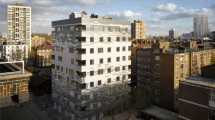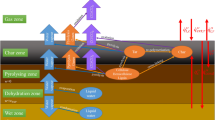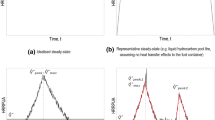Abstract
The downslope fire represents a percentage of wildland fireline while the heat transfer mechanism of this process is poorly understood. In this study, the experiments were carried out in a fuel bed of dead pine needles with the slopes of − 30°, − 20°, − 10° and 0° for 0.4 and 0.8 kg/m2 fuel loads. Flame length, flame angle, temperatures over the fuel bed, flow speed at the fuel bed surface, radiation heat flux near the end of the fuel bed were measured. The rate of spread shows a parabolic shape which decreases firstly and then increases from 0° to − 30°. The combustion interface, reconstructed from the temperature histories of two vertical thermocouples, was perpendicular to the fuel bed under all slope conditions for two fuel loads. The measured radiation heat flux is higher at − 30° slope than level ground, which is attributed to higher flame emissivity. A quasi-physical model was developed to describe the heat transfer mechanism of downslope fire spread. The calculation results show that the flame radiation dominated the downslope fire spread process and the combustion zone radiation should not be neglected in the near flame region.












Similar content being viewed by others
References
Viegas D, Varela V, Borges C (1994) On the evolution of a linear fire front in a slope. In: Proceedings of the 2nd international conference on forest fire research, pp 301–318
Dupuy J (1995) Slope and fuel load effects on fire behavior: laboratory experiments in pine needles fuel beds. Int J Wildland Fire 5(3):153–164. https://doi.org/10.1071/wf9950153
Weise DR, Biging GS (1997) A qualitative comparison of fire spread models incorporating wind and slope effects. For Sci 43(2):170–180
Mendes-Lopes JMC, Ventura JMP, Amaral JMP (2003) Flame characteristics, temperature,time curves, and rate of spread in fires propagating in a bed of Pinus pinaster needles. Int J Wildland Fire 12(1):67–84. https://doi.org/10.1071/wf02063
Viegas DX (2004) On the existence of a steady state regime for slope and wind driven fires. Int J Wildland Fire 13(1):101–117. https://doi.org/10.1071/wf03008
Butler B, Anderson W, Catchpole E (2007) Influence of slope on fire spread rate. In: Butler BW, Cook W (eds) The fire environment—innovation, management, and policy. USDA Forest Service, Rocky Mountain Research Station, Fort Collins, pp 75–83
Dupuy J-L, Maréchal J (2011) Slope effect on laboratory fire spread: contribution of radiation and convection to fuel bed preheating. Int J Wildland Fire 20(2):289–307. https://doi.org/10.1071/wf09076
Dupuy J-L, Maréchal J, Portier D, Valette J-C (2011) The effects of slope and fuel bed width on laboratory fire behaviour. Int J Wildland Fire 20(2):272–288. https://doi.org/10.1071/wf09075
Van Wagner C (1988) Effect of slope on fires spreading downhill. Can J For Res 18(6):818–820
Rossa CG, Davim DA, Viegas DX (2015) Behaviour of slope and wind backing fires. Int J Wildland Fire 24(8):1085–1097. https://doi.org/10.1071/wf14215
Andrews PL, Bevins CD, Seli RC (2003) BehavePlus fire modeling system: version 2.0: user’s guide. US Department of Agriculture, Forest Service, Rocky Mountain Research Station Fort Collins, CO
McArthur AG (1967) Fire behaviour in eucalypt forests. Australian Forestry and Timber Bureau Leaflet No.107:36
Noble I, Gill A, Bary G (1980) McArthur’s fire-danger meters expressed as equations. Austral Ecol 5(2):201–203
Xie X, Liu N, Lei J, Shan Y, Zhang L, Chen H, Yuan X, Li H (2017) Upslope fire spread over a pine needle fuel bed in a trench associated with eruptive fire. Proc Combust Inst 36(2):3037–3044. https://doi.org/10.1016/j.proci.2016.07.091
Anderson WR, Catchpole E, Butler B (2010) Convective heat transfer in fire spread through fine fuel beds. Int J Wildland Fire 19(3):284–298. https://doi.org/10.1071/wf09021
Silvani X, Morandini F (2009) Fire spread experiments in the field: temperature and heat fluxes measurements. Fire Saf J 44(2):279–285. https://doi.org/10.1016/j.firesaf.2008.06.004
Albini FA (1986) Wildland fire spread by radiation-a model including fuel cooling by natural convection. Combust Sci Technol 45(1–2):101–113. https://doi.org/10.1080/00102208608923844
De Mestre NJ, Catchpole EA, Anderson DH, Rothermel RC (1989) Uniform propagation of a planar fire front without wind. Combust Sci Technol 65(4–6):231–244. https://doi.org/10.1080/00102208908924051
Vaz GC, AndrÉ JCS, Viegas DX (2004) Fire spread model for a linear front in a horizontal solid porous fuel bed in still air. Combust Sci Technol 176(2):135–182. https://doi.org/10.1080/00102200490255343
Dupuy JL (2000) Testing two radiative physical models for fire spread through porous forest fuel beds. Combust Sci Technol 155(1):149–180. https://doi.org/10.1080/00102200008947288
Koo E, Pagni P, Stephens S, Huff J, Woycheese J, Weise D (2005) A simple physical model for forest fire spread rate. Fire Saf Sci 8:851–862. https://doi.org/10.3801/iafss.fss.8-851
Dupuy J-L, Vachet P, Maréchal J, Meléndez J, de Castro AJ (2007) Thermal infrared emission transmission measurements in flames from a cylindrical forest fuel burner. Int J Wildland Fire 16(3):324–340. https://doi.org/10.1071/wf06043
Pastor Ferrer E, Rigueiro A, Zárate López L, Gimenez A, Arnaldos Viger J, Planas Cuchi E (2002) Experimental methodology for characterizing flame emissivity of small scale forest fires using infrared thermography techniques. In: IV International conference on forest fire research 2002 wildland fire safety summit, pp 1–11
Silvani X, Morandini F, Dupuy J-L (2012) Effects of slope on fire spread observed through video images and multiple-point thermal measurements. Exp Therm Fluid Sci 41:99–111. https://doi.org/10.1016/j.expthermflusci.2012.03.021
Liu N, Wu J, Chen H, Xie X, Zhang L, Yao B, Zhu J, Shan Y (2014) Effect of slope on spread of a linear flame front over a pine needle fuel bed: experiments and modelling. Int J Wildland Fire 23(8):1087–1096. https://doi.org/10.1071/wf12189
Acknowledgements
This work was sponsored by National Key R&D Program of China (No. 2016YFC0800100) and National Natural Science Foundation of China (No. 51576184). HX Chen was supported by Science and Technological Fund of Anhui Province for Outstanding Youth (No 1808085J21) and Fundamental Research Funds for the Central University (WK2320000036).
Author information
Authors and Affiliations
Corresponding author
Rights and permissions
About this article
Cite this article
Yang, Z., Zhang, H., Zhang, L. et al. Experimental Study on Downslope Fire Spread over a Pine Needle Fuel Bed. Fire Technol 54, 1487–1503 (2018). https://doi.org/10.1007/s10694-018-0740-0
Received:
Accepted:
Published:
Issue Date:
DOI: https://doi.org/10.1007/s10694-018-0740-0




